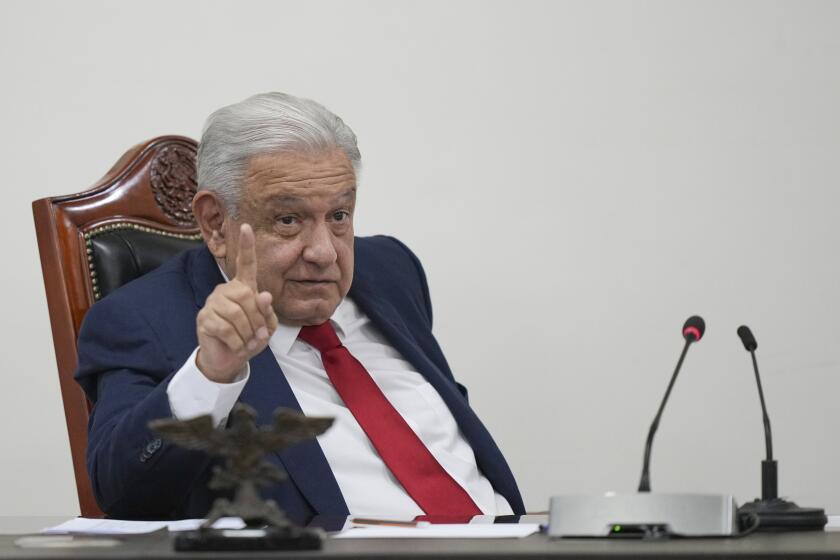Ambitions are sky-high for New Mexico spaceport
After Bill McCamley got his master’s degree from Harvard in 2003, he returned to this sleepy city in a forgotten corner of the third-poorest state in the country.
It took him nine months to find a decent job -- selling commercial real estate. That is not unusual in this part of New Mexico, where young people flee to Colorado or Texas in search of gainful employment.
But McCamley’s experience left a lasting impression. Today, he hopes to jump-start the economy in his hometown of 82,000 -- by campaigning for a state-funded spaceport to send millionaire tourists into orbit.
McCamley, 28, left his real estate job soon after he won election as a county commissioner in 2004. He has big hopes for Spaceport America, currently little more than an expanse of desert, a concrete launch pad and two temporary mission-control trailers. He’s one of dozens of believers who envision paparazzi and space enthusiasts staying at local hotels and mingling with highly paid engineers and scientists who would transform this swath of mobile homes and chile farms into a high-tech hub.
“If you look at the airline industry, I’m sure people said, ‘This is crazy,’ when it first came out,” said McCamley, waiting with 100 other guests for the first launch of an unmanned rocket from the 17,000-acre site. Moments earlier, an official from New Mexico State University in Las Cruces had touted an upcoming space conference that would also feature a rodeo. “But if you look at it, it evolved into a very stable part of our economy.”
A recent study commissioned by the state found that a fully operational spaceport could create 5,000 jobs. “To a state like Florida or California or Texas, that’s really a drop in the bucket,” said Rick Homans, director of the state’s Economic Development Department. “In New Mexico, 5,000 jobs and the PR and image that goes with it can really transform the economy of the state.”
Eight states, including Texas, Wisconsin and Utah, are considering commercial spaceports, with some hoping for a slice of the rapidly emerging space tourism industry. But space observers say that New Mexico -- an overwhelmingly rural state whose poverty rate trails only Louisiana and Mississippi -- has the most government support and private interest.
Gov. Bill Richardson wooed billionaire Richard Branson to anchor the spaceport with his business Virgin Galactic, which would construct a civilian fleet of spacecraft to fly thousands of passengers into space. Virgin Galactic has already signed up more than 1,000 space tourists, including actress Victoria Principal, “X-Men” director Bryan Singer and designer Philippe Starck.
Though the first round of passengers would probably launch from a spaceport in Mojave, Calif., Virgin said it would move operations to New Mexico once Spaceport America was completed. The New Mexico legislature last year approved $100 million to finance the project, which is expected to cost about $225 million. Construction could begin late next year.
Critics brand it as wasteful spending and say that New Mexico is pursuing the spaceport because of Richardson’s ambitions -- the former Energy Secretary is a likely contender for the Democratic presidential nomination in 2008 -- and the desperation of the isolated southern end of the state.
“This is your classic Old West story of your snake-oil salesman who comes to the dying town promising to revitalize it,” said Democratic state Sen. John Grubesic, who voted against the project. “Unfortunately, people have bought it, hook, line and sinker.”
Local officials argue that their scarcely populated region is a natural place for space launches. The site is on a plateau 4,300 feet above sea level, providing a shorter flight out of the atmosphere. The dry climate and clear weather permit reliable departures.
Boosters also point to the region’s history of Space Age innovation. The first atomic bomb was exploded a few dozen miles north during World War II. Neighboring White Sands Missile Range sends hundreds of military rockets into orbit each year, and commercial flights are banned from flying overhead, leaving airspace clear for spaceships.
“If you go to most industries and say, ‘We’re at 4,000 feet, we’ve got a lot of cows and are located next to White Sands missile base so you can’t fly over it,’ they’d say, ‘You’re crazy,’ ” McCamley said. “We have to take advantage of this. This is the one thing we’ve got that no one else has.”
Years ago, officials planted two signs along the interstate announcing the “future site of the New Mexico Spaceport.” Now a new sign announces that the county is home of the spaceport and adds: “You can get there from here!”
The tourist town of Truth or Consequences, a collection of bungalows and old brick buildings 32 miles from the spaceport site, renamed its annual Fiesta Days “Space Odyssey, 2006.”
The community is familiar with marketing gimmicks, having renamed itself after a radio quiz show in the 1950s. Josh Frankel, manager of the local Best Western, has claimed the Internet domains for spaceportlodgings.com, spaceportdining.com and spaceportguide.com.
“It’s the same way ‘electricity’ was in the 1930s and ‘television’ in the 1950s,” said Frankel, 33. “It’s a very hot word -- spaceport.”
The low-paid workforce scattered around the region has more modest hopes. In a Las Cruces parking lot, John Garcia, who works at an auto lube shop, said he hoped the spaceport would inject enough life into town so a couple more nightclubs would open. Then he wouldn’t have to drive to El Paso on weekends for entertainment.
“Maybe,” added Garcia, 28, “they’ll raise the minimum wage.”
But before it reaches for the stars, southern New Mexico has to agree to tax itself to cover part of the $225 million. As McCamley waited for the inaugural launch at the spaceport last month, he practiced his pitch.
He opened his laptop computer, knocking a science fiction paperback onto the sandy ground. On the screen were statistics for Las Cruces and Huntsville, Ala., which 50 years ago transformed itself from an impoverished rural community to the home of the Marshall Space Flight Center.
“Our median household income is $29,000,” said McCamley, a Harvard cap perched on his head. “Theirs is $44,000. Our family poverty rate is 19%. Theirs is 9.8%”
The difference, McCamley said, is that Huntsville invested in the future. “We, in all honesty, dropped the ball in the 1950s.”
One of McCamley’s fellow commissioners, Kent Evans, 66, chimed in. A former aerospace executive who worked for decades at Cape Canaveral during the space race, Evans has transformed a room in his house into a personal museum full of space memorabilia.
“I’ve seen the future, and I know what can happen,” he said. “It’s going to be a tough sell, but I think we can do it.”
The two pointed to the first signs of economic activity in Las Cruces connected to the spaceport. The X Prize Cup, a contest to design a reusable space vehicle, has been held for the last two years at the airport west of town. The Rocket Racing League, which is trying to develop a NASCAR-style sport of racing rockets, also has moved here.
The commissioners settled back to wait for liftoff. It was a failure. The rocket launched seven hours late, corkscrewed and crashed back to Earth.
Boosters argued that occasional setbacks are normal in the space race.
“That’s why there’s a term for this in the aerospace industry,” said Lonnie Sumpter, executive director of the New Mexico Spaceport Authority. “Test flight.”
*
More to Read
Sign up for Essential California
The most important California stories and recommendations in your inbox every morning.
You may occasionally receive promotional content from the Los Angeles Times.










